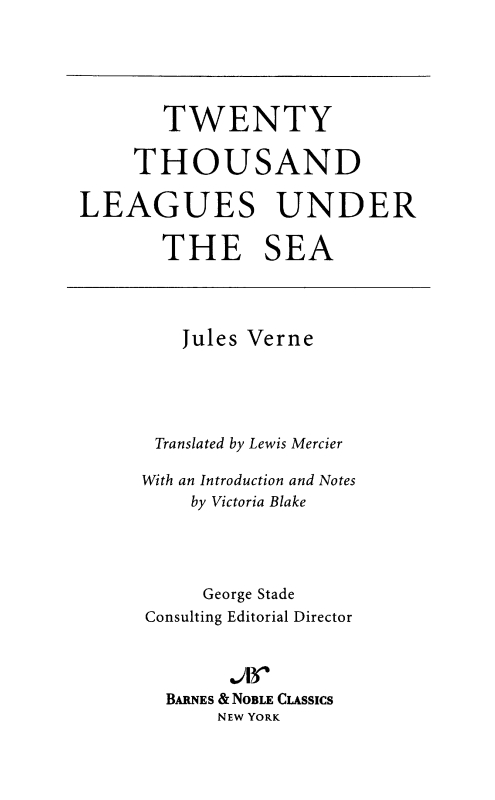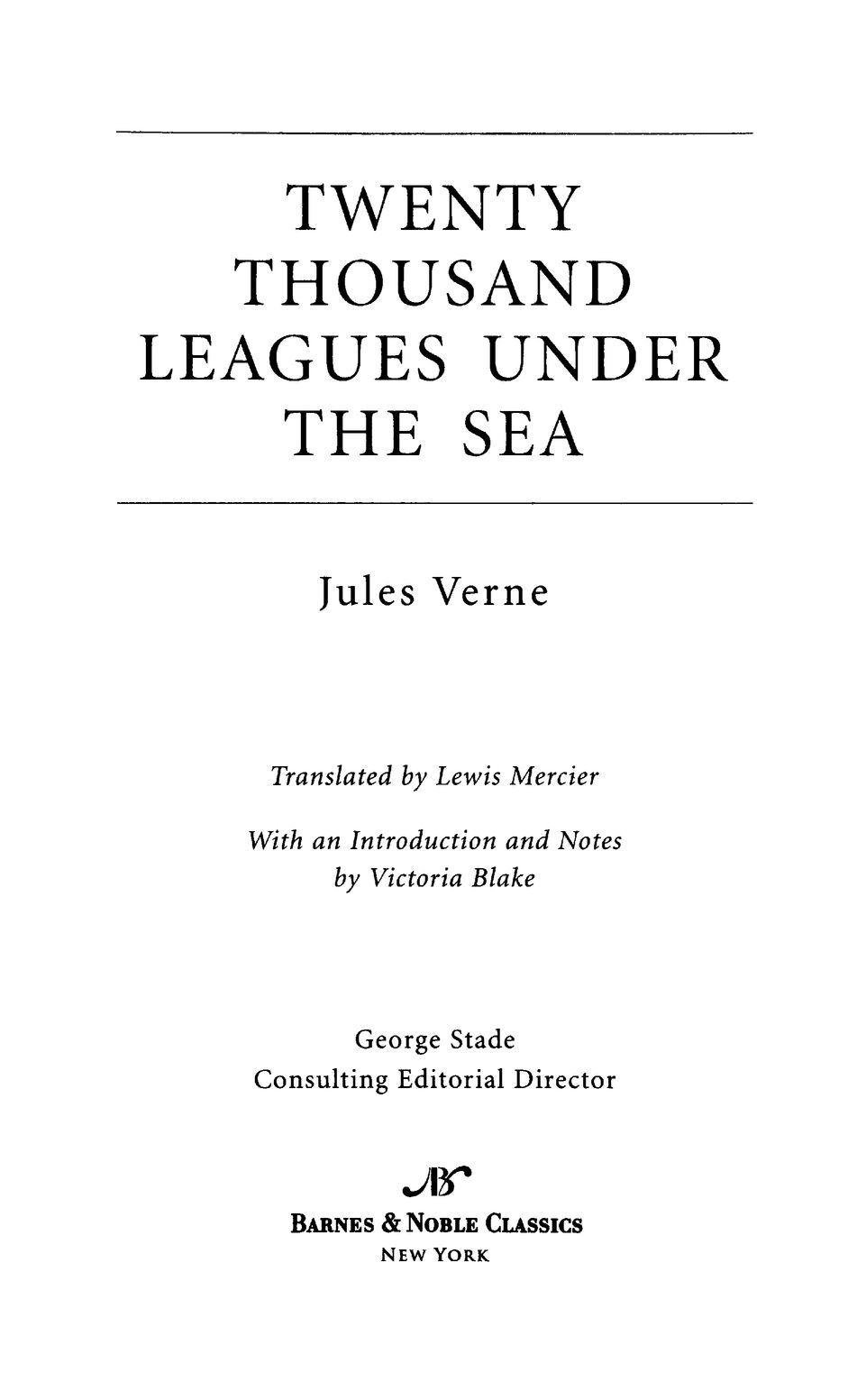Twenty Thousand Leagues Under the Sea (Barnes & Noble Classics Series)
Read Twenty Thousand Leagues Under the Sea (Barnes & Noble Classics Series) Online
Authors: Jules Verne

BOOK: Twenty Thousand Leagues Under the Sea (Barnes & Noble Classics Series)
7.46Mb size Format: txt, pdf, ePub

Table of Contents
From the Pages of
Twenty Thousand Leagues Under the Sea
Twenty Thousand Leagues Under the Sea
The year 1866 was signalized by a remarkable incident, a mysterious and inexplicable phenomenon, which doubtless no one has yet forgotten. (page 5)
The monster emerged some fathoms from the water, and then threw out that very intense but mysterious light mentioned in the report of several captains. This magnificent irradiation must have been produced by an agent of great
shining
power. The luminous part traced on the sea an immense oval, much elongated, the center of which condensed a burning heat, whose overpowering brilliancy died out by successive gradations. (page 30)
shining
power. The luminous part traced on the sea an immense oval, much elongated, the center of which condensed a burning heat, whose overpowering brilliancy died out by successive gradations. (page 30)
“The sea is everything. It covers seven-tenths of the terrestrial globe. Its breath is pure and healthy. It is an immense desert, where man is never lonely, for he feels life stirring on all sides. The sea is only the embodiment of a supernatural and wonderful existence.” (page 57)
“I owe all to the ocean; it produces electricity, and electricity gives heat, light, motion, and, in a word, life to the
Nautilus.”
(page 64)
Nautilus.”
(page 64)
Captain Nemo, by the help of his sextant, took the altitude of the sun, which ought also to give the latitude. He waited for some moments till its disk touched the horizon. While taking observations not a muscle moved; the instrument could not have been more motionless in a hand of marble. (page 74)
Evidently from some part of the vessel they had by means of a tap given entrance to the water, which was invading us, and with which the room was soon filled. A second door cut in the side of the
Nautilus
then opened. We saw a faint light. In another instant our feet trod the bottom of the sea. (page 86)
Nautilus
then opened. We saw a faint light. In another instant our feet trod the bottom of the sea. (page 86)
At this moment, the
Nautilus,
raised by the last waves of tide, quitted her coral bed exactly at the fortieth minute fixed by the captain. Her screw swept the waters slowly and majestically. Her speed increased gradually, and sailing on the surface of the ocean, she quitted safe and sound the dangerous passes of the Straits of Torres. (page 128)
Nautilus,
raised by the last waves of tide, quitted her coral bed exactly at the fortieth minute fixed by the captain. Her screw swept the waters slowly and majestically. Her speed increased gradually, and sailing on the surface of the ocean, she quitted safe and sound the dangerous passes of the Straits of Torres. (page 128)
“Steam seems to have killed all gratitude in the hearts of sailors.” (page 167)
I returned to the glass. The
Nautilus
was no longer moving, the heat was becoming unbearable. The sea, which till now had been white, was red, owing to the presence of salts of iron. In spite of the ship’s being hermetically sealed, an insupportable smell of sulphur filled the saloon, and the brilliancy of the electricity was entirely extinguished by bright scarlet flames. I was in a bath, I was choking, I was broiled. (page 186)
Nautilus
was no longer moving, the heat was becoming unbearable. The sea, which till now had been white, was red, owing to the presence of salts of iron. In spite of the ship’s being hermetically sealed, an insupportable smell of sulphur filled the saloon, and the brilliancy of the electricity was entirely extinguished by bright scarlet flames. I was in a bath, I was choking, I was broiled. (page 186)
At a signal from the captain, its screw was shipped, and its blades raised vertically; the
Nautilus
shot into the air like a balloon, rising with stunning rapidity, and cutting the mass of waters with a sonorous agitation. Nothing was visible; and in four minutes it had shot through the four leagues which separated it from the ocean, and, after emerging like a flying-fish, fell, making the waves rebound to an enormous height. (pages 218-219)
Nautilus
shot into the air like a balloon, rising with stunning rapidity, and cutting the mass of waters with a sonorous agitation. Nothing was visible; and in four minutes it had shot through the four leagues which separated it from the ocean, and, after emerging like a flying-fish, fell, making the waves rebound to an enormous height. (pages 218-219)
“Adieu, sun! Disappear, thou radiant orb! Rest beneath this open sea, and let a night of six months spread its shadows over my new domains!” (page 243)
Captain Nemo, covered with blood, nearly exhausted, gazed upon the sea that had swallowed up one of his companions, and great tears gathered in his eyes. (page 270)
If Captain Nemo still inhabits the ocean, his adopted country, may hatred be appeased in that savage heart! (page 296)


Published by Barnes & Noble Books
122 Fifth Avenue
New York, NY 10011
122 Fifth Avenue
New York, NY 10011
Vingt Mille Lieues sous les mers
was originally serialized in France between 1869 and 1870. Lewis Mercier’s translation and slight abridgement of
Twenty Thousand Leagues Under the Sea
introduced English readers to Verne’s work.
was originally serialized in France between 1869 and 1870. Lewis Mercier’s translation and slight abridgement of
Twenty Thousand Leagues Under the Sea
introduced English readers to Verne’s work.
Published in 2005 by Barnes & Noble Classics with new Introduction, Notes, Biography, Chronology, Inspired By, Comments & Questions, and For Further Reading.
Introduction, Notes, and For Further Reading
Copyright © 2005 by Victoria Blake.
Note on Jules Verne, The World of Jules Verne and
Twenty Thousand Leagues Under the Sea,
Inspired by
Twenty Thousand Leagues Under the Sea,
and Comments & Questions Copyright @ 2005 by Barnes & Noble, Inc.
Twenty Thousand Leagues Under the Sea,
Inspired by
Twenty Thousand Leagues Under the Sea,
and Comments & Questions Copyright @ 2005 by Barnes & Noble, Inc.
All rights reserved. No part of this publication may be reproduced or transmitted in any form or by any means, electronic or mechanical, including photocopy, recording, or any information storage and retrieval system, without the prior written permission of the publisher.
Barnes & Noble Classics and the Barnes & Noble Classics colophon are trademarks of Barnes & Noble, Inc.
Twenty Thousand Leagues Under the Sea
ISBN-13: 978-1-59308-302-5 ISBN-10: 1-59308-302-5
eISBN : 978-1-411-43336-6
LC Control Number 2004112105
Produced and published in conjunction with: Fine Creative Media, Inc. 322 Eighth Avenue New York, NY 10001
Michael J. Fine, President and Publisher
Printed in the United States of America
QM
5 7 9 10 8 6 4
Jules Verne
The creator of the
roman scientifique,
the popular literary genre known today as science fiction, Jules Gabriel Verne was born in the port town of Nantes, France, in 1828. His father, Pierre, was a prominent lawyer, and his mother, Sophie, was from a successful ship-building family. Despite his father’s wish that he pursue law, young Jules was fascinated by the sea and all things foreign and adventurous. Legend holds that at age eleven he ran away from school to work aboard a ship bound for the West Indies but was caught by his father shortly after leaving port.
roman scientifique,
the popular literary genre known today as science fiction, Jules Gabriel Verne was born in the port town of Nantes, France, in 1828. His father, Pierre, was a prominent lawyer, and his mother, Sophie, was from a successful ship-building family. Despite his father’s wish that he pursue law, young Jules was fascinated by the sea and all things foreign and adventurous. Legend holds that at age eleven he ran away from school to work aboard a ship bound for the West Indies but was caught by his father shortly after leaving port.
Jules developed an abiding love of science and language from a young age. He studied geology, Latin, and Greek in secondary school, and frequently visited factories, where he observed the workings of industrial machines. These visits likely inspired his desire for scientific plausibility in his writing and perhaps informed his depictions of the submarine
Nautilus
and the other seemingly fantastical inventions he described.
Nautilus
and the other seemingly fantastical inventions he described.
After completing secondary school, Jules studied law in Paris, as his father had before him. However, during the two years he spent earning his degree, he developed more consuming interests. Through family connections, he entered Parisian literary circles and met many of the distinguished writers of the day. Inspired in particular by novelists Victor Hugo and Alexandre Dumas (father and son), Verne began writing his own works. His poetry, plays, and short fiction achieved moderate success, and in 1852 he became secretary of the Theatre lyrique.
In 1857 he married Honorine Morel, a young widow with two children. Seeking greater financial security, he took a position as a stockbroker with the Paris firm Eggly and Company. However, he reserved his mornings for writing. Baudelaire’s recently published French translation of the works of Edgar Allan Poe, as well as the days Verne spent researching points of science in the library, inspired him to write a new sort of novel: the
roman scientifique.
His first such novel,
Five Weeks in a Balloon,
was an immediate success and earned him a publishing contract with the important editor Pierre-Jules Hetzel.
roman scientifique.
His first such novel,
Five Weeks in a Balloon,
was an immediate success and earned him a publishing contract with the important editor Pierre-Jules Hetzel.
For the rest of his life, Verne published an average of two novels a year; the fifty-four volumes published during his lifetime, collectively known as
Voyages Extraordinaires,
include his best-known works,
Around the World in Eighty Days
and
Twenty Thousand Leagues Under the Sea.
Begun in 1865 and published to huge success in 1869,
Twenty Thousand Leagues
has been translated into 147 languages and adapted into dozens of films. The novel also holds the distinction of describing a submarine twenty-five years before one was actually constructed. As a tribute to Verne, the first electric and nuclear submarines were named
Nautilus.
Voyages Extraordinaires,
include his best-known works,
Around the World in Eighty Days
and
Twenty Thousand Leagues Under the Sea.
Begun in 1865 and published to huge success in 1869,
Twenty Thousand Leagues
has been translated into 147 languages and adapted into dozens of films. The novel also holds the distinction of describing a submarine twenty-five years before one was actually constructed. As a tribute to Verne, the first electric and nuclear submarines were named
Nautilus.
Other books
The Horror Squad 2 by TJ Weeks
The Town Mouse and the Spartan House by Terry Deary
Hot Demon Nights by Elle James
Shattered by Dick Francis
Notes to the Complete Poetical Works of Percy Bysshe Shelley by Mary Wollstonecraft Shelley
A Cry From Beyond by WR Armstrong
On the Scent by Angela Campbell
The Merry Monarch's Wife by Jean Plaidy
Asked For by Colleen L. Donnelly
Unclouded Summer by Alec Waugh
